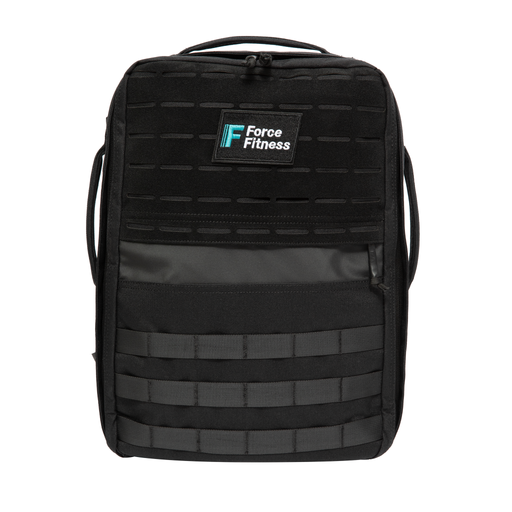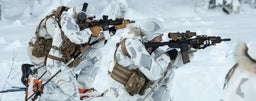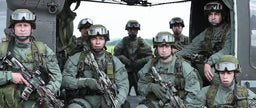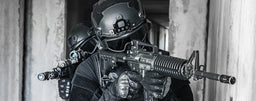
Forged in Rain, Mud & Frost: Britain’s Harshest Training Grounds
What the SAS, SBS & Royal Marines Teach Us About Winter Fitness, Rucks, and Resilience
When you picture winter training in Britain you probably think of cold showers, rainy mornings and slipping around in mud. For the elite of the Special Air Service (SAS), Special Boat Service (SBS) and Royal Marines, that environment is the weapon. From the bogs of the Welsh uplands to the snow and ice of Norway, Britain offers some of the toughest natural training grounds in the world—and the lessons translate directly into functional fitness, weighted-vest rucks and outdoor workouts. In this article we’ll highlight which UK terrain these units train on, pull real quotes and anecdotes from servicemen, and then distill training & survival tactics you can apply this winter.
Britain’s Harshest Training Grounds
Brecon Beacons, Wales
The heights of Pen y Fan in the Brecon Beacons are legendary in special forces selection: weighted yomp with full bergen, navigating in wind and rain, under fatigue. While extremes of heat made headlines in the past, the same terrain is brutal in winter—with wind, mist and cold crests forming a cruel training ground.
Dartmoor & the English South-West moors
Misty, slippery, damp and unpredictable. The environment keeps you honest—and trains you not only to move but to adapt.
Scottish Highlands & Arctic Outposts
For the Royal Marines especially, winter warfare training in Norway is the ultimate yard-stick. In one deployment, temperatures hit –30 °C. Marine Stuart Bryant summed up the mindset: “It takes a while to get used to the cold, but keeping busy and active takes your mind off it.” These locations force resilience, improvisation, and cold-weather functional strength.
Winter Training Tactics from Special Forces & How You Can Use Them
1. Prioritise Load, Movement & Terrain
Special forces training in such terrain isn’t about endless running—it’s about loaded movement: rucks, weighted packs, sleds, moving across broken ground under load and weather. If you’re training with a weighted vest, think terrain, inclines, mud, and long walks rather than just flat runs.
2. Keep Moving (Even When You’d Rather Stop)
In cold, damp, muddy conditions a big danger is becoming static. Stopping = cooling, muscle stiffness, risk of injury. As the Royal Marines Arctic training noted: staying active keeps the mind off the cold. So between sets or during your recovery walks, keep moving—bands, light body-weight drills, walking in boots, vest on.
3. Kit Discipline is Non-Negotiable
Just as the SBS and Royal Marines must keep gear dry, functioning, accessible—so you should. Use a high-quality weighted vest that sits snug, choose footwear with grip for mud/ice, dry spare socks, have a hydration plan for cold weather. In winter: wet socks, damp base layers, chilled gear = performance killer and risk multiplier.
4. Cold-Weather Survival Mindset
From ice-water immersion drills to snow shelters, UK forces practice surviving and operating in cold. For example, the “ice-breaker” in the Arctic training forces recruits to recognise cold-shock and keep focus. For the civilian fitness athlete: plan transitions (warm-up, warm-down), have a plan if the weather turns, consider doing part of your session indoors or sheltered if conditions become extreme.
5. Use Terrain & Conditions to Your Advantage
Muddy hills, wind-exposed ridges, cold drizzle—they all become resistance tools. If you ever feel your vest or boots slipping on a muddy bank—good, you’re training stability under fatigue.
6. Mental toughness & discipline
Elite forces don’t train only when conditions are perfect. They train despite them. The ability to show up, strap on your vest, and go through the movement when it’s cold, wet and windswept is a huge asset. One ex-soldier reflected: “You don’t have to be a marine to make a good Arctic soldier, but you must be able to endure the cold.”
Britain’s Harshest (and Best) Winter Training Grounds for Rucking
Brecon Beacons, Wales – The SAS Selection Ground
The Brecon Beacons are infamous in military circles as the ultimate test of endurance. SAS selection marches — known as “the Fan Dance” — take place here, involving a 24km load march over Pen y Fan carrying 25kg or more. Expect bogs, unpredictable weather, biting winds, and punishing inclines.
Ruck tip: Start from Storey Arms and follow the Pen y Fan loop. Even a 10km weighted march here will test your cardio, balance, and grit.
“It’s the equivalent of doing six marathons over five days, over the mountains, with weight on your back, with nobody to help or push you.” — Robin Horsefall, former SAS veteran
Dartmoor, Devon – Royal Marine Country
This is where the Royal Marines are forged. Dartmoor is cold, wet, and endlessly deceptive — bogs disguised as solid ground, fog that rolls in fast, and relentless drizzle that tests kit management as much as endurance.
Ruck tip: The Princetown to Postbridge route is a great challenge — open moorland, exposed ridges, and sections of boggy terrain that simulate real military conditions.
“There’s a reason the Corps keeps coming back here. If you can keep moving through Dartmoor, you can keep moving anywhere.” — Ex-Royal Marine instructor
The Lake District, Cumbria – Steep, Cold and Unforgiving
While not a military training ground per se, the Lake District mirrors the Brecon terrain but adds steeper climbs and more technical footing. Used by military units for navigation and endurance drills.
Ruck tip: Try the Helvellyn or Scafell Pike trails with a moderate load — conditions can shift from calm to sideways hail in minutes.
The Scottish Highlands – SBS and Arctic Prep
The Highlands are where cold-weather warfare skills are honed before units deploy to Norway. Rugged, freezing and remote, it’s about resilience and self-sufficiency.
Ruck tip: The Cairngorms National Park is the perfect test — long-range visibility one minute, snow flurries the next. Practice navigation and cold-weather layering here.
“As British soldiers we don’t often soldier in -20°C or this kind of depth of snow. It presents equipment challenges, clothing challenges, as well as different tactics.”
— Jim Hadfield, Commanding Officer, UK Training Battlegroup
Norway – The Royal Marines’ Arctic Playground
Technically not the UK, but part of the Royal Marines’ regular deployment cycle. Here, temperatures plummet below -30°C, and troops practice living, moving, and fighting in deep snow.
Ruck tip: Take lessons from their routines — layer smartly, eat calorie-dense foods, keep gear dry, and train the mental side of endurance.
Salisbury Plain, Wiltshire – The Army’s Year-Round Training Hub
Vast open plains, military tracks, and woodland sections make Salisbury Plain a mix of speed and stamina work. In winter, it becomes a mud bath.
Ruck tip: Public footpaths around the perimeter (such as near Imber Range) are accessible and provide long flat marches with occasional climbs — ideal for endurance-building.
Applying It to Your Winter Training
To make this actionable:
-
Ruck with intent: Strap on your vest (start moderate: 5-10% bodyweight), pick muddy hills or exposed terrain, walk 60-90 mins.
-
Functional circuits outdoors: Use bodyweight and bands—push-ups, lunges, step-ups on uneven ground, pull-ups on tree branches or portable bar.
-
Active recovery walks: Don’t just rest—walk in the cold, keep circulation going, mobility work with band stretching.
-
Kit checklist: dry base layer, mid-layer, outer shell, gloves, warm socks, vest, hydration (warm drink or insulated bottle), spare socks.
-
Mindset drill: Pick one session per week that you commit to even if conditions are awful. It builds resilience and discipline.
-
Track conditions & adapt: If it’s freezing rain, maybe shorten the session but maintain intensity. If wind chill is extreme, emphasise movement and kit protection over heavy load.
The UK’s wet, cold, muddy and unforgiving terrain isn’t a hindrance—it’s an asset for strength, resilience and functional fitness. The SAS, SBS and Royal Marines train in these conditions not because they have to, but because the conditions train them. They teach that movement under load, equipment discipline, mental grit and terrain adaptation are key.
At Force Fit our ethos maps onto this. Whether you’re hitting rucks, weighted vest circuits or outdoor functional workouts, your elements are your gym—and winter is your advantage. Train in the mud, carry the load, embrace the cold. You’ll come out stronger, tougher and ready for anything.
















